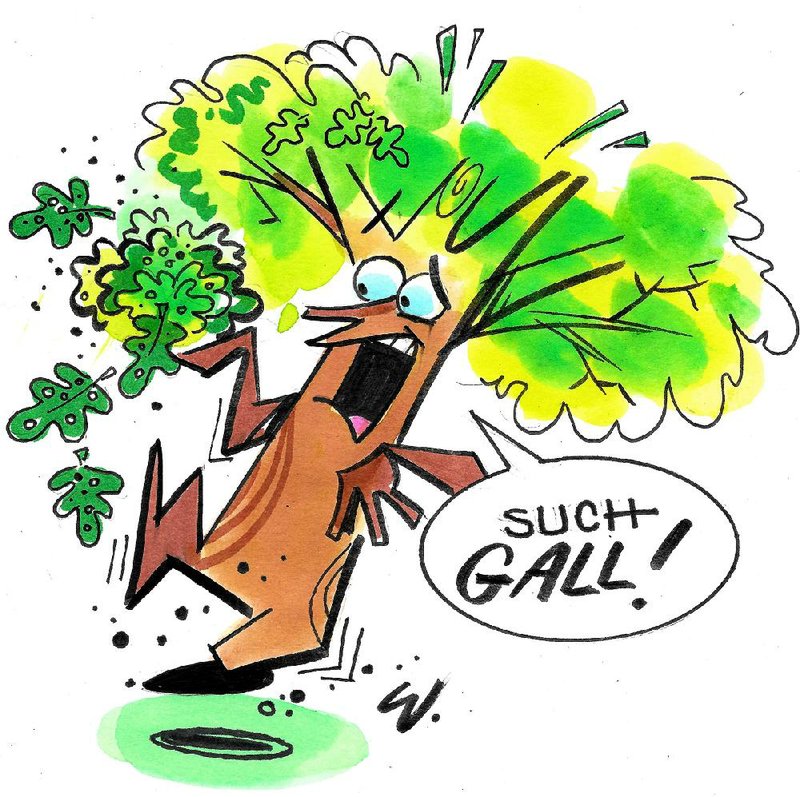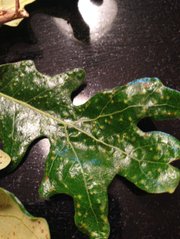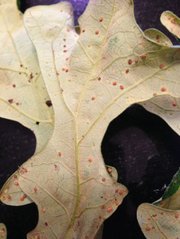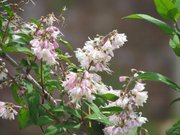Q My oak tree has some type of insect or disease on it. There are spore-looking spots on the backs of the leaves. The spots are circular flakes on the back of the leaf, but there are also spots, and tiny holes, on the corresponding location on the front. The flakes fall off and have littered the deck beneath the trees. Can you identify them?
A It is another type of gall called jumping oak gall. The small, round, button-like discs are on the undersurface of the leaf. Each disc contains one wasp larvae that sometimes jumps after it falls off and lands on the ground. Affected leaves will then have a small brown spot with a yellow halo on the upper surface. In early summer, when the larva is mature, the gall falls off the leaf, leaving a brown pockmark. On the ground, the fallen galls may jump due to the movement of the larva inside the gall. This jumping helps the gall move into leaf litter or cracks in the soil where the larva will overwinter. There is no treatment since by the time you see this, the damage is done and it is too late to control. It is usually more a nuisance than life-threatening. The best thing you can do for your trees is to keep them healthy with regular watering when it's dry.
Q This bush [the reader sent photographs] was grown from a cutting I took from a bush on the lawn in front of Old Main at the University of Arkansas, Fayetteville. The original bush no longer exists. I have been unable to identify the bush. The blooms are pink-white, and they coincide with the privet blooms but have no fragrance that I can detect. Any help you can provide in identifying these would be greatly appreciated.
A The plant in question is a deutzia -- Deutzia scabra. While there are new varieties with varying mature heights, the old-fashioned one typically grows 6 to 10 feet tall with a 4- to 6-foot spread. There can be a light fragrance in the blooms. It blooms best in full sun but will tolerate partial sun. It is not too particular about soil type as long as it is well drained. It blooms in the spring. It can be grown as a specimen plant or a hedge.
Q I was wondering if you can tell me what this is on our English peas. The leaves are turning solid white with a white, powdery coating. This usually happens every year at the end of their producing.
A You have a pretty spectacular case of powdery mildew. I think that weather plays a part, and higher temperatures typically signal the end of the growing season for English peas. English peas are cool-season crops. They drastically slow down production when the temperature begins to warm up. Higher temperatures begin the decline and vigor of the plants, which makes them more susceptible to diseases. All the rain we had exacerbated it. Some varieties such as "Terrain" and "Cavalier" are resistant to powdery mildew. Resistance doesn't mean they can't get it, but they are more tolerant. Since it only happens at the end of the season, I would not worry too much about it.
Q I was wondering if you could write a bit about anemones and ranunculus. I know the fall-blooming anemones will grow in Arkansas, but how about the De Caen anemones (Anemone coronaria) and the Grecian windflowers (Anemone blanda)? I have never seen these growing in gardens here, but the catalogs say they are Zones 4-9. Ranunculus bulbs are also listed as Zones 6-9, but I have not seen them growing in Arkansas either. I would like to try them, since they are not supposed to be attractive to deer.
A Ranunculus bulbs and the Anemone coronaria are usually best treated as annuals in Arkansas. While they will grow and bloom for a season, they typically will not come back. I have had a few of the De Caen anemones come back after two years, but they flowered sporadically. The Anemone blanda will naturalize and can come back for years, forming a low-growing mat of foliage with white flowers. They are best planted in a well-drained site with some protection from the hot afternoon sun. I usually buy a few ranunculus plants in late winter for extra color, but when they are through I toss them. They do not like the heat of an Arkansas summer.
Janet B. Carson is a horticulture specialist for the University of Arkansas Cooperative Extension Service. Write to her at 2301 S. University Ave., Little Rock, Ark. 72204 or email her at
jcarson@arkansasonline.com
HomeStyle on 06/10/2017



